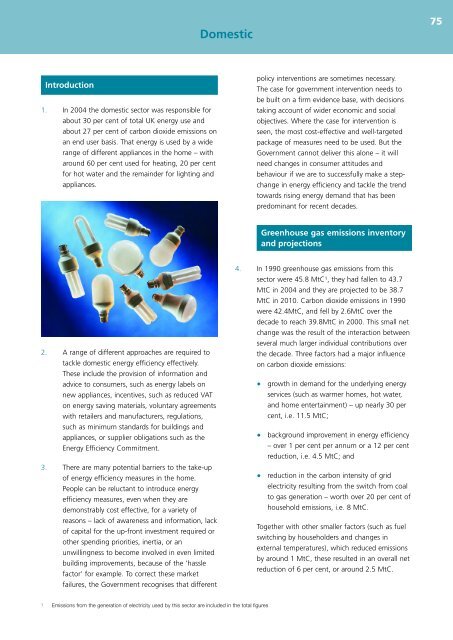UK Climate Change Programme 2006 - JNCC - Defra
UK Climate Change Programme 2006 - JNCC - Defra
UK Climate Change Programme 2006 - JNCC - Defra
You also want an ePaper? Increase the reach of your titles
YUMPU automatically turns print PDFs into web optimized ePapers that Google loves.
Domestic<br />
75<br />
Introduction<br />
1. In 2004 the domestic sector was responsible for<br />
about 30 per cent of total <strong>UK</strong> energy use and<br />
about 27 per cent of carbon dioxide emissions on<br />
an end user basis. That energy is used by a wide<br />
range of different appliances in the home – with<br />
around 60 per cent used for heating, 20 per cent<br />
for hot water and the remainder for lighting and<br />
appliances.<br />
policy interventions are sometimes necessary.<br />
The case for government intervention needs to<br />
be built on a firm evidence base, with decisions<br />
taking account of wider economic and social<br />
objectives. Where the case for intervention is<br />
seen, the most cost-effective and well-targeted<br />
package of measures need to be used. But the<br />
Government cannot deliver this alone – it will<br />
need changes in consumer attitudes and<br />
behaviour if we are to successfully make a stepchange<br />
in energy efficiency and tackle the trend<br />
towards rising energy demand that has been<br />
predominant for recent decades.<br />
Greenhouse gas emissions inventory<br />
and projections<br />
2. A range of different approaches are required to<br />
tackle domestic energy efficiency effectively.<br />
These include the provision of information and<br />
advice to consumers, such as energy labels on<br />
new appliances, incentives, such as reduced VAT<br />
on energy saving materials, voluntary agreements<br />
with retailers and manufacturers, regulations,<br />
such as minimum standards for buildings and<br />
appliances, or supplier obligations such as the<br />
Energy Efficiency Commitment.<br />
3. There are many potential barriers to the take-up<br />
of energy efficiency measures in the home.<br />
People can be reluctant to introduce energy<br />
efficiency measures, even when they are<br />
demonstrably cost effective, for a variety of<br />
reasons – lack of awareness and information, lack<br />
of capital for the up-front investment required or<br />
other spending priorities, inertia, or an<br />
unwillingness to become involved in even limited<br />
building improvements, because of the ‘hassle<br />
factor’ for example. To correct these market<br />
failures, the Government recognises that different<br />
4. In 1990 greenhouse gas emissions from this<br />
sector were 45.8 MtC 1 , they had fallen to 43.7<br />
MtC in 2004 and they are projected to be 38.7<br />
MtC in 2010. Carbon dioxide emissions in 1990<br />
were 42.4MtC, and fell by 2.6MtC over the<br />
decade to reach 39.8MtC in 2000. This small net<br />
change was the result of the interaction between<br />
several much larger individual contributions over<br />
the decade. Three factors had a major influence<br />
on carbon dioxide emissions:<br />
• growth in demand for the underlying energy<br />
services (such as warmer homes, hot water,<br />
and home entertainment) – up nearly 30 per<br />
cent, i.e. 11.5 MtC;<br />
• background improvement in energy efficiency<br />
– over 1 per cent per annum or a 12 per cent<br />
reduction, i.e. 4.5 MtC; and<br />
• reduction in the carbon intensity of grid<br />
electricity resulting from the switch from coal<br />
to gas generation – worth over 20 per cent of<br />
household emissions, i.e. 8 MtC.<br />
Together with other smaller factors (such as fuel<br />
switching by householders and changes in<br />
external temperatures), which reduced emissions<br />
by around 1 MtC, these resulted in an overall net<br />
reduction of 6 per cent, or around 2.5 MtC.<br />
1 Emissions from the generation of electricity used by this sector are included in the total figures
















